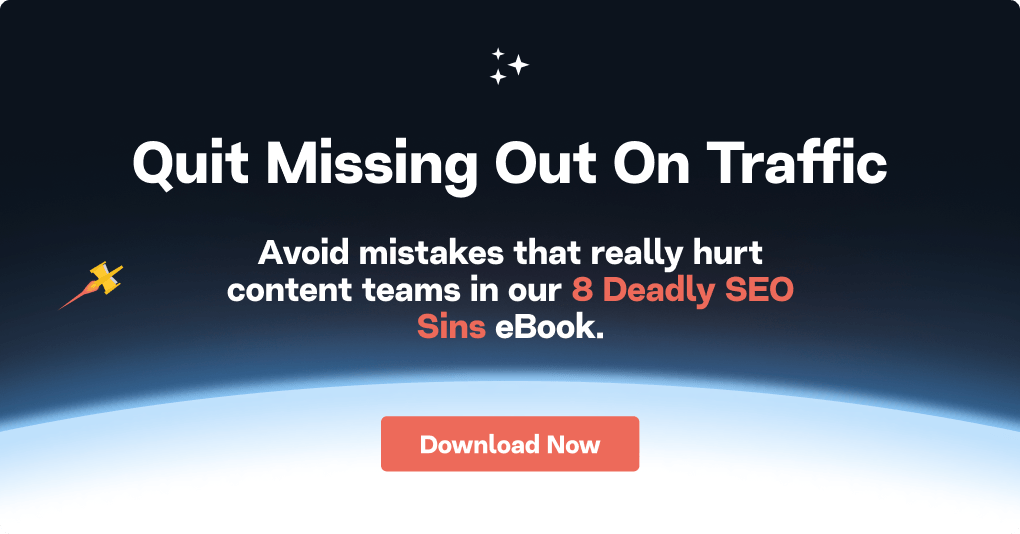All SERP Click-through Rates Are Not The Same
I’m surprised at how often this trips people up, but all SERP click-through rates (CTR) are not the same. Yet, there are tools out there that base their predictive estimates using the same static calculation.
This is what most marketers roughly take as an average:
- 30% for number position one
- 15% per position two
- 5% for position three
- 1% for the next few positions
- Even lower percentages after that
The exact numbers are irrelevant because the problem is that this approach discounts any impact of SERP features. There are Google SERP features that steal clicks, not always in a bad way because they are helping users. Still, you’ve got ads, featured snippets and answer boxes, where Google has decided to provide an immediate answer, and more.
Here’s an example to illustrate the point. The #1 ranking organic result for “what is content marketing” appears at the very bottom of the first page of the search results in Google. That’s due to the presence of a number of SERP features which push the organic result further down the page and compete for attention.

Let’s use the above averages to compare the difference when SERP features are taken into account. If you don’t take them into account then the CTR for the first organic result (the Content Marketing Institute’s URL) is 30%.
Taking into account the SERP features paints a dramatically different story. All those features push the organic result to the bottom of the page. That’s the same place that the #10 organic result would reside, if there were no SERP features. Based on the averages above, an organic listing at tenth position on the first page has less than 1% CTR.
That’s a huge difference!

These all affect the amount of traffic going to the organic results and their impact varies depending on the search phrase. That’s why applying a static click-through rate to search volume is highly inaccurate.
Another factor affecting click-through rate is fractured intent. It may sound a little esoteric, but all it means is that sometimes Google doesn’t know exactly what you’re asking for. So they give you a buffet of things:
- Pages that satisfy early stage awareness
- Some that are middle of the funnel
- Maybe there’s this other meaning for the search term
In situations of fractured intent, the intent you serve will impact the click-through rate. For example, if the majority of Searchers are looking for one meaning and you’re addressing the other one, your click-through rate will be low.
Estimating CTR at a high level, without accounting for search features, results in poor predictability.
Fortunately, you have access to all of this, at least for the pages for which you already rank, using Google search console. Using your browser to access the application limits you to an artificial cap of 1,000 words.
Get a Google search console API account and you can get all your data, including all of your current true click-through rates. There are also data sets available, such as GrepWords, that provide real world click-through rates on your pool of keywords.
At the very least, get your Google search console API on the words you already rank for. Look at some of them and see what the click-through rate is for first position. You’ll probably see a lot of variance between search times, 300% is not uncommon.
Then you’ll realize how far off your estimates actually are. It’s a really big problem for teams estimating how much traffic their content will generate and setting expectations based on that.
So imagine 90% of teams doing the three things we’ve talked about (volume-prioritized keyword research, link data in isolation, applying static click-through rate). Any predictions for their content plans will be wildly inaccurate based on these three data points.
Some SEOs believe that ads don’t affect click-through rates. But I don’t buy that. Average click-through rate in an ad unit is over 10% depending on the number of pixels covered.
We studied a hundred thousand search results and found that only 30% of the results on the first page were above the fold. That’s in the cases where you have 10 organic listings on a results page set. There are some search queries that only have three listings.
Internally, Google even says that search results pages are no longer about 10 blue links. Google that and you’ll see for yourself.
So if you’re calculating your search click through-rates based on 10 blue links, you’re leaving yourself wide open to error.
What you should do now
When you’re ready… here are 3 ways we can help you publish better content, faster:
- Book time with MarketMuse Schedule a live demo with one of our strategists to see how MarketMuse can help your team reach their content goals.
- If you’d like to learn how to create better content faster, visit our blog. It’s full of resources to help scale content.
- If you know another marketer who’d enjoy reading this page, share it with them via email, LinkedIn, Twitter, or Facebook.
